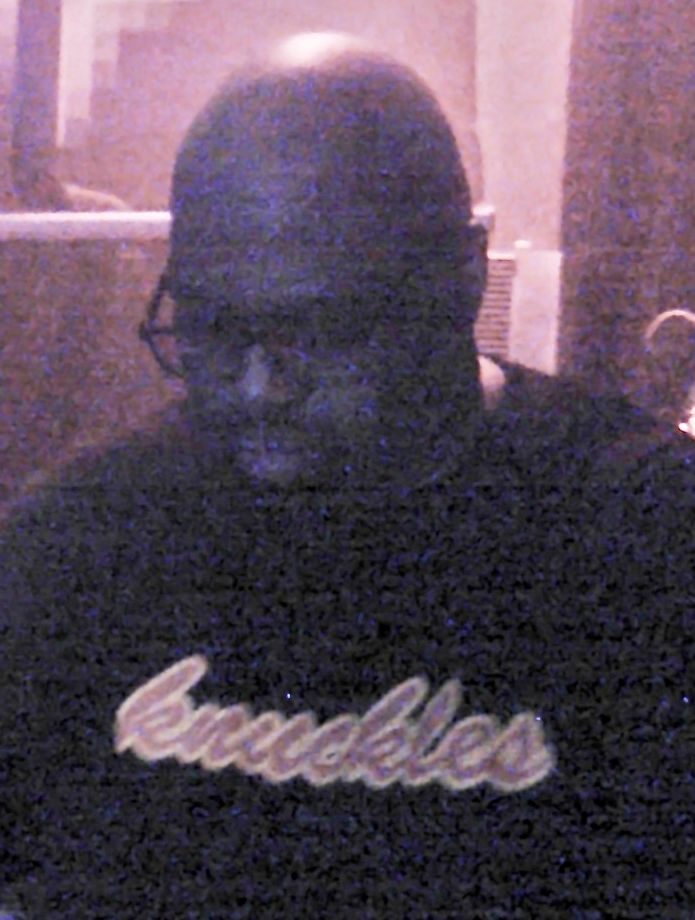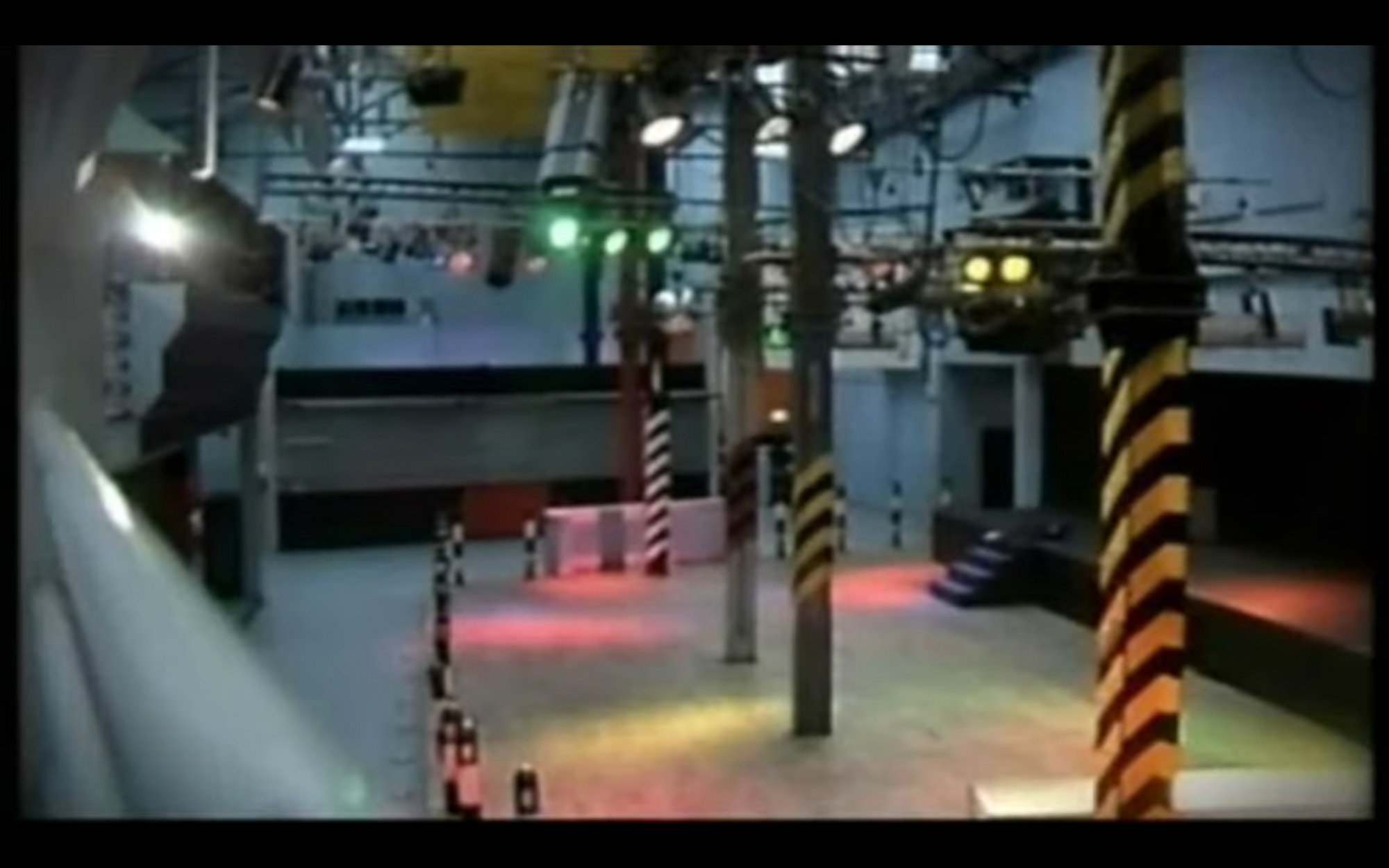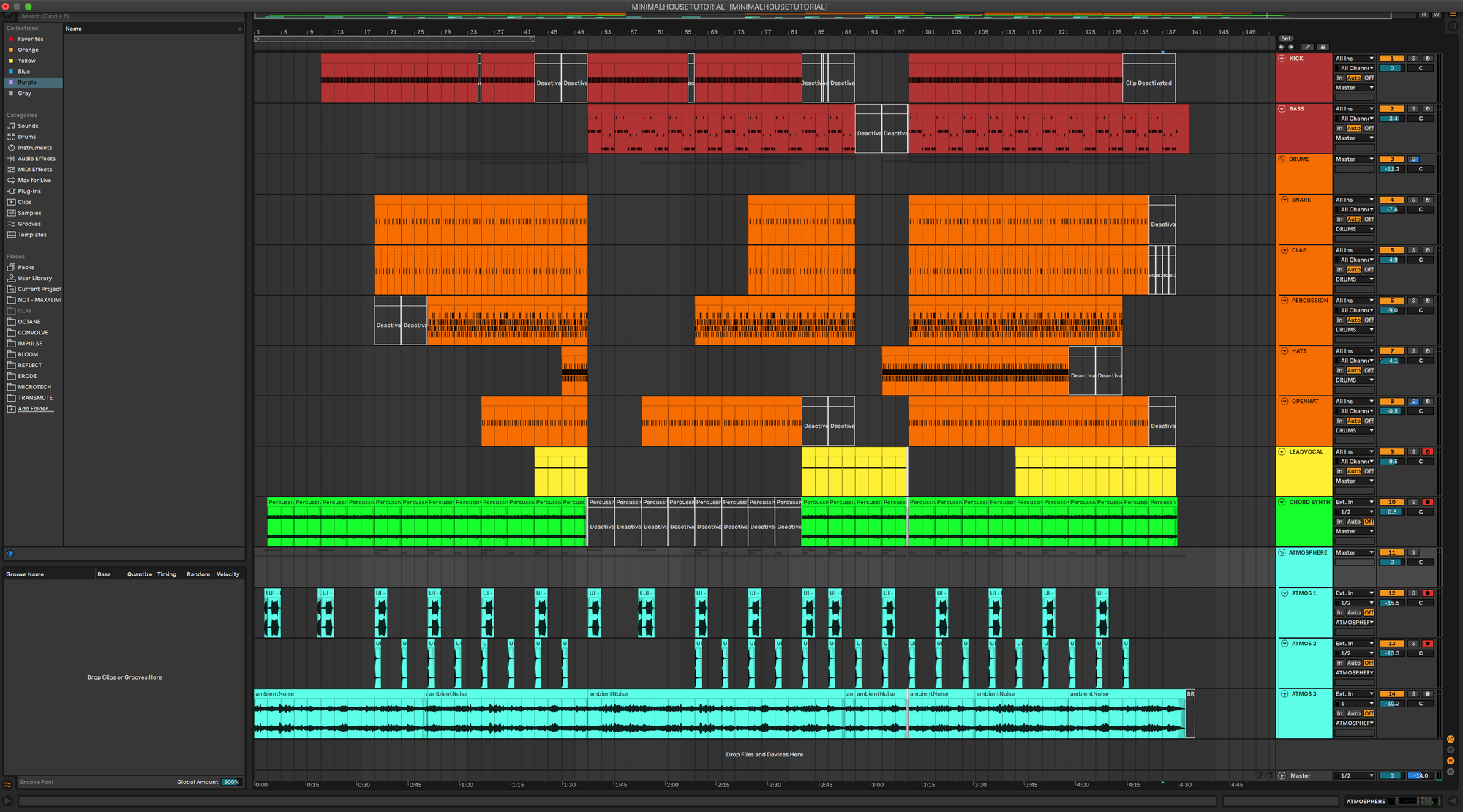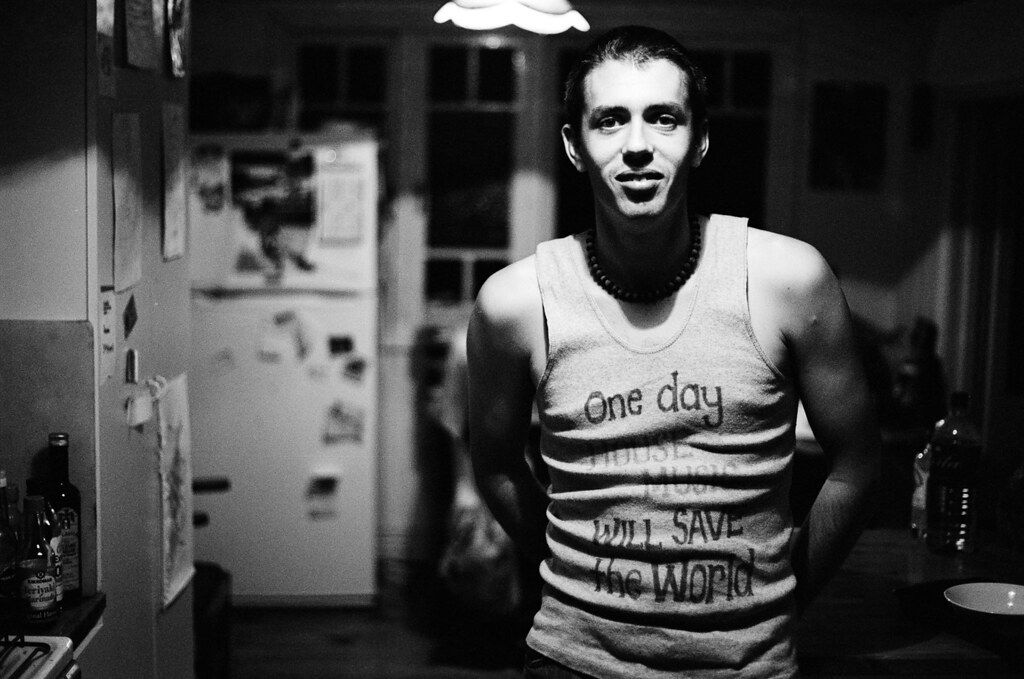Hey everybody it’s Jake T. with Minimal Audio. We’re back once again to take a look at one of the most important genres in the history of dance music. This time we’re talking about house. Anyone interested in the musical cannon should study the genre, it and Techno have laid the foundations for every other type of dance music that came after it. It is one of the cornerstones in the history of electronic music, and by learning the fundamentals of its aesthetic and production you can apply them to almost any of your own works in progress.
To fully grasp what makes house so special, we need to discuss two main points. To start, I'll talk about the mechanical aspects of its production. We'll take a look at a small demo song I’ve made, where I’ll illustrate the techniques that I’ve used to create it. I’ll also include captures of the various sequences in the song, in case you want to follow along and program them into your own DAW.
Second, I'm going to talk about some of the ethos and aesthetics of house music. This can get a little heady, but it's important to understand the underlying motivations and goals of a house track. This is a genre with an over 30-year history, yet it still serves the same function now as it did in the 80s. That's because there is a soul inside house music that is equally as important to understand as its raw productional ingredients. Once we have a solid grasp on both the how and the why of the genre, we will be able to create productions that are far more impactful, yet retain house's signature sense of elegance.
Let's get started!
Meet Me at the Warehouse

Before we talk about production, I want to briefly go over some early house music history. This is a revolutionary art form with radical origins, and any conversation about the genre needs to begin by honoring them. House is first and foremost a black and queer genre of music. It was invented by the resident DJs of a night club in Chicago called The Warehouse located west of the city’s South Loop. The Warehouse was initially a member’s-only club where queer black men would be able to connect without having to deal with the every day prejudices of the late 70s and early 80s. It was only after the venue started gaining popularity that it opened its doors to a wider audience. Legend tells that this is also the place where house music got its name as the wild blends of styles being mixed by the venue’s performers were colloquially coined “Warehouse Music.” That term would later be shortened to just “House,” and a genre was born.
The Rhythm of Your Love

The mastermind behind the Warehouse’s signature style was the club’s musical director Frankie Knuckles. He sought to expand his role as a DJ by applying new kinds of mixing techniques into his performances. Knuckles’ innovations were numerous, but what would become his most famous invention was his blend of funk, electro, and disco records punctuated by a drum machine. This blend of real-world and synthetic soundscapes created the proto-versions of the house music that we know today. His edits were characterized by their long-lasting grooves and deeper bass than anything found on a commercial release. This drove the dance floor crazy and would distinguish the DJ as a vital force in Chicago’s nightlife.
New Acts Start to Follow
Around this time a plethora of Chicago DJs became just as daring in the club, and the city saw the rise of creative forces like Ron Hardy and Jessie Saunders. Saunders holds special distinction as one of the first of his generation of DJ/producers to release a single called “On and On.” Eventually, other artists (including Knuckles) would unveil their own singles and the genre started to permeate outside the city.
House Expands Beyond Its Borders

In the mid-1980s, house's influence expanded past the borders of Chicago, and into other cities like New York and Detroit (which was already in the midst of its own musical revolution with the advent of techno.) Through an intermingling of the radio, mixtapes created from recordings of the DJs' performances, and a handful of official releases; house was able to pierce the public consciousness. Labels such as Trax Records and DJ International played a significant role in that dissemination by releasing tracks from veterans like Frankie Knuckles as well as emerging artists such as Larry Heard, Marshall Jefferson, and Adonis.
Across the Pond

It wasn't long before house crossed the Atlantic and found an audience in the United Kingdom. There it became closely associated with the emerging rave culture, and led to the country's adoption of "Acid House." The UK’s acid scene exploded in the late 1980s, characterized by its use of the Roland TB-303 synthesizer and the distinctive squelchy sound of the synthesizer's filter.
Permutations Start to Form

Throughout the 90s, house continued to evolve and diversify. Subgenres such as deep house, progressive house, and garage emerged, each with its own distinct set of characteristics and aesthetics. These new sounds were championed by labels like Strictly Rhythm, Defected, and many others that would become major players in the global house scene.
Robot Rock

House Music’s popularity continued to soar into the 2000s, with artists like Daft Punk, and Swedish house Mafia achieving mainstream success. This era coincided with the rise of the DAW and several online platforms that further facilitated house's global reach. This allowed artists from all over the world to share their productions
Today, house music remains a dominant force in electronic music. The genre's influence has become enormous, and it continues to evolve through the experimentation and creativity of both established and emerging artists. When you consider how deeply it has permeated the culture in such a relatively short amount of time; it is no exaggeration to say that house has changed the world.
Let's Build Our First Track

Now, that we've had a brief overview of house music's origins and many permutations, It's time to get our hands dirty and produce a track. I've gone ahead and made an example song that we'll comb over piece by piece in order to understand all of the elements that come together to make a full production.
Overview
Before we start let's do some housekeeping. First, the DAW I made this song with is Live 11, the session is 123 bpm, and the key of the piece is in D major. All of my drum sounds are from Minimal's Octane sample pack and have had minimal processing done to them (for example, I did nothing to the kick, the sample just sounds that good). The two synth sounds present are the "House Bass" preset that Live comes with and a chord progression that makes use of a polyphonic synthesizer. Additionally, the only plug-ins I used were Cluster Delay, and Rift as well as some third-party magic on the master for loudness. The samples I used in the piece are from Transmute and an online sample library. I wanted to keep this track as simple as possible so that new producers can follow along easily and not get mired in sound design (we'll save that for another tutorial)
Now that we've gotten that out of the way, let's break this beat down!
The Drums
The drums are the most important piece of any dance music. Pure and simple, if your drums alone don't have you dancing in your seat you probably need to rethink your sequence. So why is that? Well, almost all music, but dance music in particular works off of a track's metre (pronounced meter). This is the pulse or tempo of your song, and it's what propels the piece forward. Your drums are what outline and define that metre. They're what's telling the body when to move when to dial it back, and when to let go and shake it! Every element present in a house track should be in service to the main pulse of your song, and this pulse is dictated by the piece's metre.
So what is the pulse of house music exactly? I've found that it's the push and pull of the kick and the open hat. That constant eighth-note pulse is what keeps your body glued to the track and allows all of the song's other elements to shine through.
The Kick
In dance music, the kick is your most powerful compositional tool. The structure of your song is defined by its presence or absence. In the track that we've created, the sequence I made for our kick pattern looks like this.

Notice, how I'm still placing the kick on every quarter note? This retains the piece's pulse and maintains the kick's compositional function. When I deviate from that pulse it is to create musical tension that prepares the listener for a change to occur. That change can be, simply taking the kick out, adding or subtracting an instrumental element, or starting a sweep of a synth's filter. It's up to you to decide what is appropriate in the context of your piece. In house music, a good rule to follow is the rule of 32. That means that after every 32 bars (or eight measures if you're going by your DAW's timeline) an element of your song needs to change. Since so many songs are written with this form in mind, our ears are already prepared for it. This makes our track's progression feel natural to the listener. It's important to understand though, that you want to show a level of restraint when you operate in this space. Ultimately house music is meant to be DJ'ed and nothing clears a dance floor quite like messing with the groove every eight measures. Finding that balance between landing and transition is the key to a great house song.
The Hats


Now that we've established our kick let's move on to the second most important part of our track. Our hats! In house music, the open hat is an essential piece of percussion. It serves as the counterbalance to our kick and can be a great tool for increasing the intensity and tension in our song. When we take a look at our closed hats, notice that we have four separate sequences; yet each sequence covers the same rhythmic ground? This is because hats in house music often stay pretty static. One way we can add variation to our hats is by layering our main 16th note pattern with different samples to accentuate different parts of the beat. This allows our hats to feel like they're moving while remaining static enough that they contrast against the syncopation of the other percussion.
The Percussion

The percussion of a house song is somewhere in between ornamental and melodic. Your percussion lines should try to exist as full musical phrases on their own. That way when placed next to your kicks and hats, you have a recurring motif that locks in nicely with the rest of the piece. This is the most challenging part of any house production as your percs often take the most fine-tuning to get right.
The Clap and Snare


Finally, let's close our drum section out with the clap and the snare. These are usually simple figures meant to accent the other pieces of your "kit." Generally in house music, the clap stays rigid, hitting the two and the four of the sequence. This allows the snare to be a little more complex. However, it's important to remember that these two drums are meant mainly for accentuating the groove that is already present. You don't want too much variation.
The Chords
Since we have the main rhythmic elements of our track locked in with our drums, it's time to move on to our chords. In house, chords are often used as soulful harmonic elements that feature simple figures played in repetition. Something to keep in mind here, and throughout all of your productions is that simplicity is not synonymous with the words basic, or boring. Some of the greatest house music ever written has a ton of variation and still only moves between two chords.

For our harmony, I chose a simple one-five progression. What gives the chords their house-y flavor is the way we voice them. In this case, I chose to omit our fifth, and only use the one, major third, and the seventh of the chords D and A in the D major scale. In the case of D, the seventh is major, and in the case of A the seventh is a minor interval. This gives the part a distinctive house flavor yet lays back in the groove enough that it can serve as a nice bed for our bass, and lead vocal.
The Bass

For the bass line, I created this simple melodic figure that reinforces the pulse of our chords without taking attention away from it. In this sequence, I made sure to stick as closely to the root of each chord as possible. Only deviating to create a quick feeling of tension, that is quickly resolved by the following note. Keep in mind that this tension is still locked within the notes of our chord (in this case a major third) that's because to sound harmonically stable we need our bass's notes to stay within the scope of the chord progression established by our synth. This creates a simple, and effective line that reinforces the beat as a whole while remaining rhythmically and tonally interesting.
The Samples
A fixture of house music is its use of sampling. Often in these types of songs, samples of vocal lines are used for the leads of these tracks. I emulated that aesthetic through a sample I purchase from a third-party sample library. For our sequence, you can see that I went as simple as possible.

Pay no attention to the note value displayed. The reason I am sequencing G-sharp is simply because to my ear this was the most correct tuning I could get the sample to D major. Often when working with samples you'll run into this problem as your sampler will often start the un-pitched version of your sample on C, regardless of its actual starting pitch. If you have trouble hearing the tuning of the sample, that's ok! Using a tuner here can be a great way to help attune your ears to the harmonic relationship between your sample and the rest of your song.
The Arrangement
Now that we've finished outlining the elements of our piece, we can finally talk about the most important part of any song: its arrangement. The execution of a track's arrangement is the determining factor between whether or not it's a certified club classic or just some trash we'll never listen to again. You can have the greatest lead lines and chord pairings in the world, but if you don't deploy them properly. No one's going to be interested. Remember, a little while ago when I was talking about the rule of 32? This is where it comes into focus.
If you'll take a look at the song I've demoed for us, you'll notice that I follow this rule to a T. The second the chords start playing we're locked into an eight-measure formic structure that lasts until the very last synth hits. Take a moment and listen with that in mind. Doesn't it feel familiar? Like you've heard it many many times before? That's because you have! Numerous house tracks follow this simple formula. The trick here is to not view this as a restraint but as a latticework on which we can build creatively. All art has some formic restrictions, but it's through those restrictions that artists reach new levels of expression. This should be the same for our productions! House music thrives on the balance between tradition and experimentation, pushing those boundaries while honoring its roots is our job as producers.
As you delve deeper into the house music formula, you will discover hidden nuances and variations that add depth and excitement to your productions. Doubling the length of a part here, cutting a part early there. These are all powerful tools in the arrangement of one's song. However, we must learn the rules before we learn when to break them. So if you're just starting do not be afraid to keep your song's structure simple. Eventually through meticulous attention to detail, subtle shifts in rhythm, and imaginative layering of sounds you will be able to captivate listeners and take them on a journey through the landscape of house music.
Just as the painter creates their masterpiece within the confines of a canvas, we, as music producers, weave sonic tapestries within the structure of our chosen genre. It is through our embracing of the inherent restrictions of house music, we tap into the collective consciousness of its history and connect with listeners on a profound level. We honor the legacy of those who came before us while leaving our unique imprint on the genre. It is through this delicate balance of tradition and innovation that we propel house music forward, ensuring its longevity and continued relevance in the ever-evolving landscape of popular music.
To conclude this entry into our blog, I'd like to leave you with two impressions.
The first is that yes, house is a genre with serious motivations, but remember that the music is the escape. It's supposed to be fun. By understanding the key elements of house, mastering its essential techniques, and embracing experimentation, you too can craft unforgettable tracks that resonate with listeners and fill dance floors. The road to becoming a skilled producer may be challenging, but with dedication, perseverance, and an open mind, you have the power to create your own unique sound and contribute to the vibrant and ever-evolving conversation of not just house, but music as a whole!
Second, I want us to reflect upon how fundamentally important house is to the history of electronic music. This is a genre that carved a lane for an entirely new form of music, that could only be achieved through advancements in music technology. Without house, the landscape of not only dance but electronic music in general would be unrecognizable. What started in a Warehouse in Chicago has blossomed into a cultural phenomenon that's spread to every corner of the planet. But beyond its infectious rhythms and soulful vocals, the genre carries a deeper meaning. It represents unity, inclusivity, and escape. It creates a space where everyone can come together and lose themselves in the music. It provides a sanctuary for people who are weary and seeking solace from that infinite jagged edge of everyday life. For a lot of people house is their home.
That wraps up our look into house music, I hope reading it was as inspiring for you as writing it was for me. Join us back here next week for a deep dive into the wild world of MorphEq!
If you've read all this and are still in the mood for some more house, then check out some of my favorite tracks.
Ron Hardy, Live at The Music Box 1986
Crystal Waters, 100% Pure Love
And if you found some of the sounds on this track inspiring, consider following these links to our plug-ins and sample packs!


